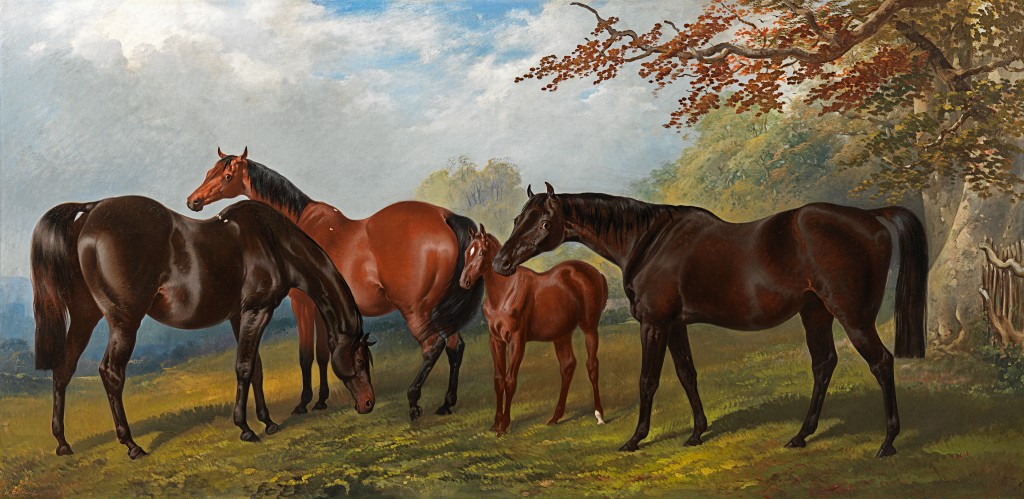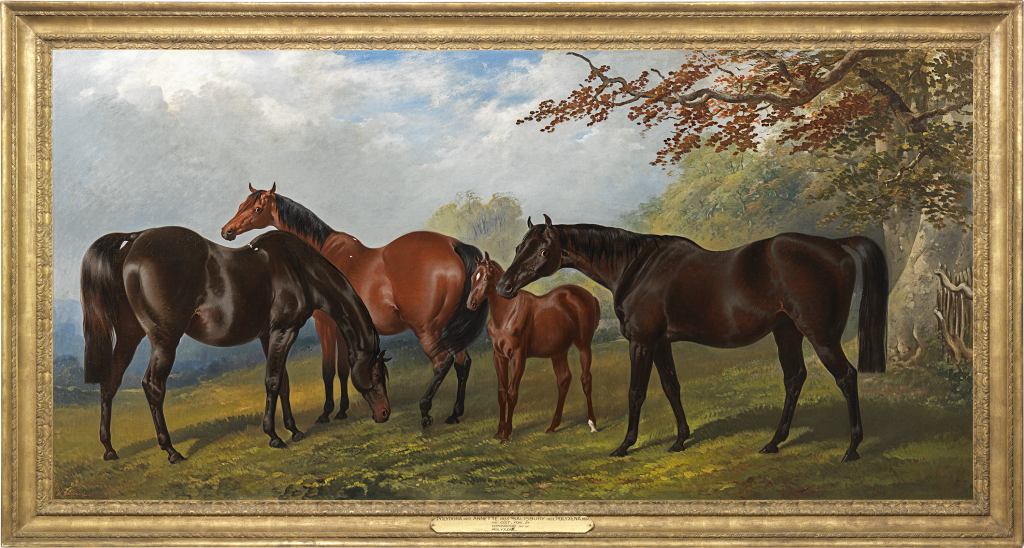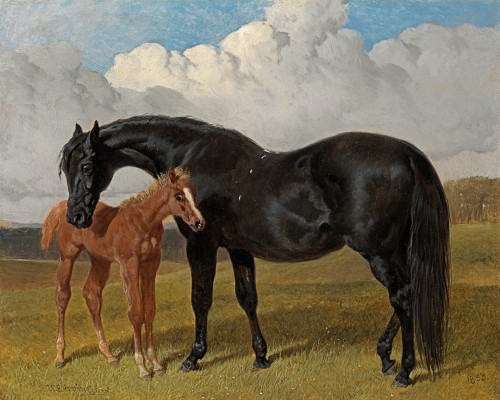HENRY BARRAUD
1811 - London - 1874
Ref: CB 109
The Althorp Mares: Annette, Polyxena and Polydora with her chestnut foal
Signed and dated lower left: H. Barraud
Oil on canvas: 39 x 78 ½ in / 99.1 x 199.4 cm
Frame size: 46 x 87 in / 116.8 x 221 cm
Painted circa 1860
Engraved:
For The Sporting Magazine, June and December 1860
Provenance:
By descent in the Spencer family to
Edward John Spencer, 8th Earl Spencer (1924-1992), Althorp, Northamptonshire
Matti Huhanantii
Richard Green, London, 1993;
private collection, USA
Literature:
The Sporting Magazine, June 1860, pp.432-33, illus. with an engraving by E Hacker adapted from the left-hand side of the painting
The Field, 9th June 1860, p.476
The Sporting Magazine, December 1860, p.436-37, illus. with an engraving by E Hacker adapted from the right-hand side of the painting
KJ Garlick, ‘A catalogue of pictures at Althorp’, The Walpole Society, vol. 45, 1974-76, p.3, no.25
The Spencer family of Althorp have a long association with horseracing and hunting; their magnificent picture collection has included many sporting works. John Wootton (1686-1764) was commissioned in 1733 to provide large equestrian subjects for Althorp’s entrance hall, which are still in situ today. The same year Roger Morris created the stable block in mellow golden ironstone, with an imposing Palladian portico. The Spencers’ interest in agricultural advances and selective breeding led to the acquisition of such works as the Portrait of a Shorthorn bull, c.1845 (Althorp House).
Henry Barraud portrayed several of the Althorp brood mares in the mid-nineteenth century[1]. This painting depicts Annette, Polyxena and Polydora with her chestnut foal in the lush, wooded Northamptonshire estate. Annette was described by The Sporting Magazine in 1860 as ‘by far the most famous’[2] of the three mares. Bred in Ireland by Mr RW Whaley, she was by the 1830 Derby winner Priam out of a Don Juan mare. She was acquired by the Whig politician Frederick, 4th Earl Spencer (1798-1857) in 1852. Annette’s best progeny were Nina, which won six races worth 1,665 gns in 1848-9 and Glenmasson, with four races worth 1,396 gns from six starts in 1856-8. Annette was still living and in foal in December 1860, when The Sporting Magazine reported: ‘Her own brother Paladin was a winning horse at Newmarket, and, in fact, almost everything out of “the old mare” has shown some good about it’[3].
Polyxena, foaled in 1837, was another daughter of Priam, bred by Mr J Osborne out of a Cerberus mare; she came from the Byerley Turk line. Polyxena never ran, but her daughter Dacia by Gladiator ran second for the Cesarewitch in 1848 and won the Cambridgeshire Stakes two weeks later. After her second foal, Polyxena was ridden as a favourite hack by the 4th Earl Spencer’s daughter Lady Georgiana Spencer, who sadly died aged nineteen in 1852. Polyxena subsequently had several foals by the 1843 2000 Guineas and Derby winner Cotherstone, a horse acquired for the Althorp stud for 3,000 guineas upon his retirement in 1844.
Polydora was bred by the Duke of Portland in 1837, by Priam out of Manto. She had a modest racing career and several foals by Cotherstone. Her offspring Polydore, Pandora and Polyolbion won races in the 1850s and 60s. The Sporting Magazine comments that, although the three mares in Barraud’s painting were more than twenty years old, they were still producing good foals: ‘In fact, nearly all Lord Spencer’s mares are good breeders, a point that depends no little on the way in which they are looked after, and that tells proportionately for Mr. Wilson the stud groom’[4].
HENRY BARRAUD
1811 - London - 1874
Born into an unusually talented family whose accomplishments included medicine, horology, photography and painting, Henry Barraud distinguished himself as a portraitist and a sporting artist. He excelled in painting equestrian portraits and more general scenes, peopled with identifiable figures and numerous horses and hounds.
Henry was the younger brother of William Barraud (1810-1850), who also became a sporting artist. Their father William, a clerk in the Custom House, descended from a family of Huguenot watchmakers; their mother Sophia was the daughter of the miniature painter Thomas Hull. Henry studied with the portrait painter JJ Middleton. The Barraud brothers shared studios in Soho and Cornhill from 1835 until William’s death in 1850 and collaborated on many paintings. They also produced a book entitled Sketches of Figures and Animals, published by H Graves and Co. circa 1850.
Henry exhibited regularly at the Royal Academy from 1833 to 1859 and at the British Institution from 1831 to 1864. Some of his later work, such as his painting of infant choristers, We praise thee, O God, appealed to Victorian sentimentality and inspired a best-selling engraving. He also portrayed Lord’s cricket ground and Gladstone’s first Cabinet, 1868 (formerly in the National Liberal Club, London). Henry Barraud was a keen photographer and his portrait of Lord Palmerston, 1865, was taken from a photograph. In 1842 he married Anna Maria Rose and around 1858 converted to Catholicism. Among his nine children, Barraud’s son Herbert started a photographic business; Francis James Barraud (1856-1924) painted the famous image of a dog listening to a gramophone which became the HMV logo, His Master’s Voice. Henry Barraud died in London in 1874.
[1] A painting of a Grey mare, Grisette and Wizard, signed and dated H. Barraud 1858, oil on canvas 28 x 36 in / 71.1 x 91.4 cm, is listed as no.24 in Garlick’s ‘Catalogue of pictures at Althorp’, op. cit., p.3.
[2] December 1860, op. cit., p.436.
[3] Ibid., p.437.
[4] Ibid., p.437.

























